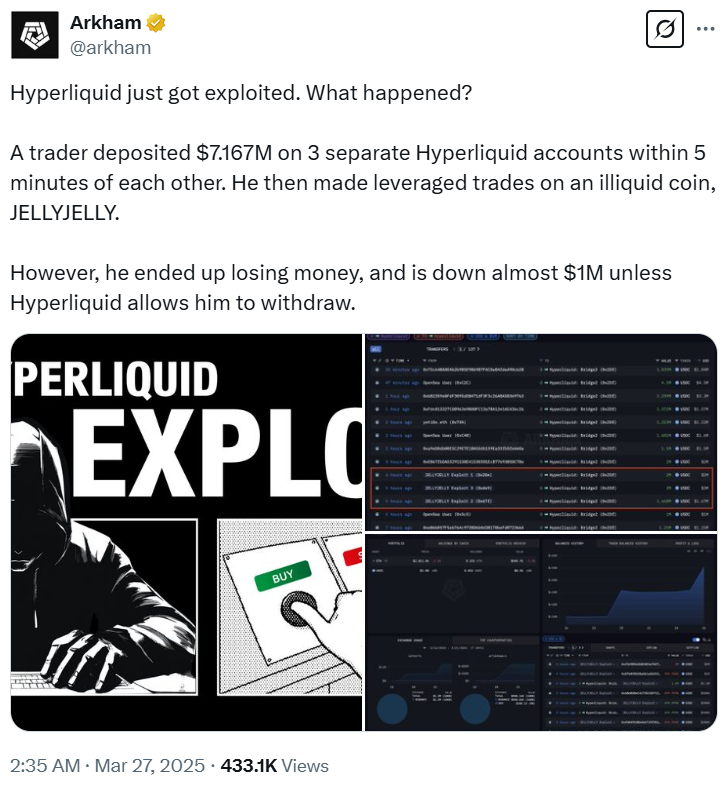- Hyperliquid lost $12 million on suspected market manipulation of JELLYJELLY but was able to convert it into a profit of $703,000.
- The exchange delisted JELLYJELLY and locked trader accounts, creating additional issues as users had to liquidate holdings.
- This was Hyperliquid’s second liquidity fright in two weeks, eroding confidence and causing its native token, HYPE, to lose more than 30% in a month.
Hyperliquid, a decentralized exchange, faced a major problem when the price of the meme currency JELLYJELLY suddenly increased by 500%.
This sudden price increase seemed to be the consequence of market manipulation, threatening to cost the exchange $12 million.
But before things got out of control, Hyperliquid’s team intervened, took control of the situation, and surprisingly converted what would have been a massive loss into a $700,000 profit.
To avoid further inconvenience, trading on JELLYJELLY was immediately suspended by the exchange.
Source: X

A Complex Web of Market Manipulation
The trouble began when a trader took an $8 million short position on JELLYJELLY, a relatively low-cap token.
Based on data monitored by AP Collective founder Abhishek Pawa, the trader then intentionally withdrew margin, which resulted in Hyperliquid’s liquidity vault (HLP) inheriting and auto-liquidating the short position.
The trader also bought JELLYJELLY tokens elsewhere, which made the token pump on-chain. Consequently, his own short position was forced to liquidate.
As JELLYJELLY’s price continued to rise, Hyperliquid’s liquidator vault took in the enormous short position, sending its unrealized loss to about $12 million. The token’s market capitalization increaseed from about $20 million to as high as $50 million before the exchange delisted it.
Adding to the chaos, a new wallet created to take advantage of the price manipulation, identified as beginning with “0x20e8,” rode the wave. This trader went long on JELLYJELLY and, as the price increased, was able to profit by more than $8 million.
Had the price of JELLYJELLY kept increasing and reached a market cap of $150 million, Hyperliquid’s liquidator vault was at risk of being fully liquidated.
Matters were made worse when Binance and OKX revealed that they were listing JELLYJELLY on their futures markets, raising concerns that the price of the token would continue climbing.
In reaction, Hyperliquid hurried to suspend trading on JELLYJELLY before ultimately confirming its delisting on X.
Drastic Measures and the Aftermath
In spite of the intervention, the situation worsened in yet another unexpected turn.
The exchange limited traders’ accounts to reduction-only orders, meaning they couldn’t open new trades. Thus, traders ended up selling off tokens from the first account in order to accumulate some funds despite still having millions in unrealized gains.
As the crisis deepened, Hyperliquid’s validators intervened and reset JELLYJELLY’s price to $0.0095, the same price at which the whale had originally set their short position. This allowed the platform to close 392 million JELLY JELLY tokens, basically converting a possible multi-million-dollar disaster into a $703,000 profit.
To avoid further exploitation, Hyperliquid instantly closed all existing JELLYJELLY positions and took the token off its platform. The team also vowed to reimburse affected users, except flagged addresses suspected to be involved in the scheme.
Hyperliquid’s response has elicited a divided reaction. Some appreciated the exchange for promptly acting to curtail losses, but others faulted its approach.
Bitget CEO Gracy Chen likened its response to that of a centralized exchange, while BitMEX co-founder Arthur Hayes also expressed concerns regarding the strategy.
This is Hyperliquid’s second major liquidity scare in just two weeks. Previously, the exchange was involved in another crisis when a whale Ethereum long liquidation worth $200 million left its liquidity vault down by $4 million.
These consecutive events have eroded confidence in the platform, with its native token, HYPE, dropping over 12% in one day and over 30% in one month.
Also read : Open AI Ghibli’s Unrealistic Image Generations You Must See



